Series of blasts in northern Chinese city of Tianjin; dozens killed
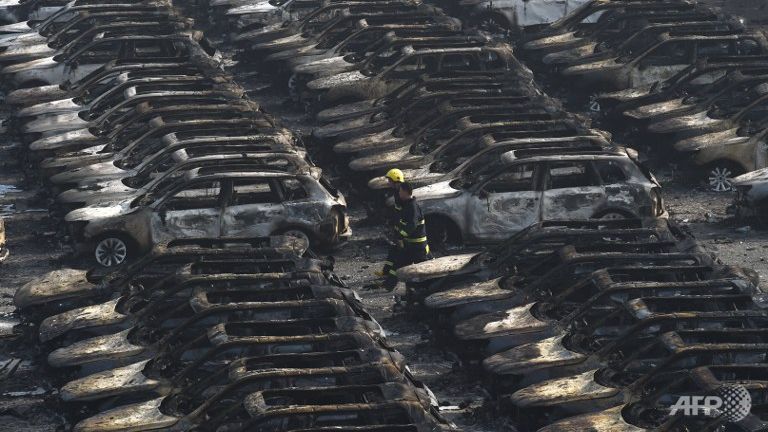 |
| Firefighters walk past rows of burnt out Volkswagen cars near the site of a series of explosions in Tianjin. (Photo: AFP/Greg Baker) |
TIANJIN: A series of massive explosions at a warehouse in the northern Chinese port city of Tianjin killed at least 4 people, state media reported on Thursday (Aug 13), as witnesses described a fireball from the blasts ripping through the night sky.
China's CCTV reported the tolls on Twitter, adding that President Xi Jinping had urged "all-out efforts to rescue victims and extinguish fire," as a blaze continued to rage at the site where more people were feared to be trapped.
An AFP reporter at the scene saw shattered glass up to three kilometres from the blast site, after a shipment of explosives detonated in an industrial zone raining debris on the city.
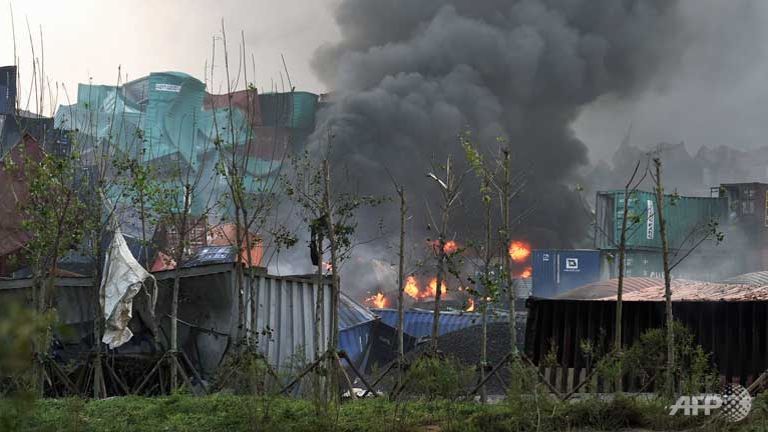 |
| A series of massive explosions at a warehouse in Tianjin, northern China, killed 13 people, state media reported. (AFP PHOTO/GREG BAKER) |
Plumes of smoke billowed over buildings six hours after the explosion, which occurred around 11.30pm local time (12.30am Singapore time Thursday).
Communist Party newspaper the People's Daily said 17 people were killed in the explosion in a post on Chinese social network Weibo, adding in a separate post that more remained trapped by a huge fire unleashed by the explosives.
Two firefighters called to the scene were missing, Xinhua said, as 10 emergency teams and 35 fire trucks battled the blaze.
Between 300 and 400 injured people had arrived at one hospital, the Beijing News reported, citing a worker at another saying there were too many new patients to count.
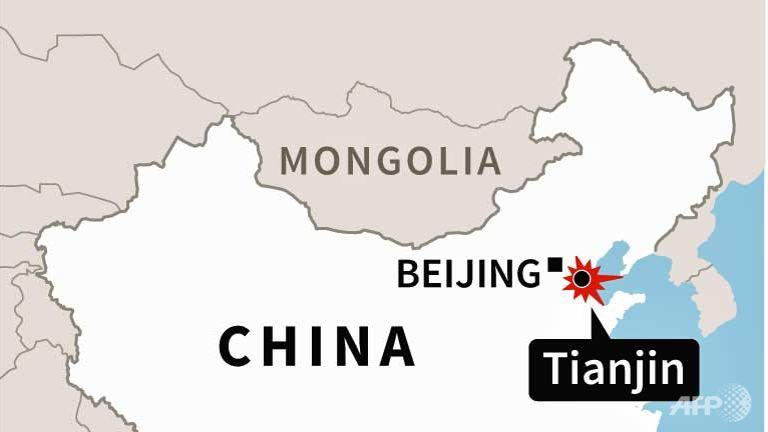 |
| Map of Tianjin, site of a major explosion, in China. (AFP Photo) |
"The fireball was huge, maybe as much as 100 metres tall," said 27-year-old Huang Shiting, whose house is close to the port area of the city where the explosion took place. "I heard the first explosion and everyone went outside, then there was a series of more explosions, windows shattered and a lot of people who were inside were hurt and came running out, bleeding," he told AFP.
Much of the area surrounding the explosion is made up of construction sites for residential and office buildings. Worker dormitories, built of flimsy sheets of thin metal, were torn apart by the blast.
The magnitude of the first explosion was the equivalent of detonating three tons of TNT, the China Earthquake Networks Centre said on its verified Weibo account, while a second was the equivalent of detonating 21 tons of the explosive.
Images obtained by AFP showed residents, some partially clothed, running for shelter on a street strewn with debris. Photos posted on Weibo showed people carrying children covered in blankets to safety, though their veracity could not immediately be confirmed.
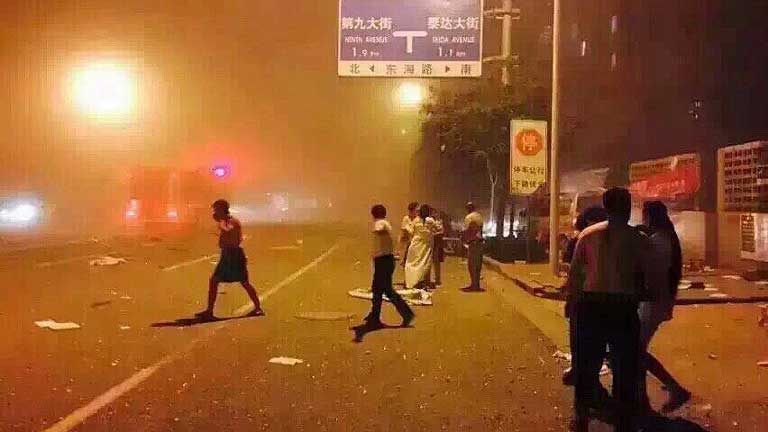 |
| This photo taken with a mobile phone and received from a Weibo user shows people taking shelter on a street after the explosion (AFP Photo) |
The blast is said to have occurred at a warehouse of Ruihai Logistics, an appointed company of Tianjin Maritime Authority. Established in 2011, Ruihai Logistics handles the transit and distribution of hazardous goods.
POOR SAFETY RECORD
China has a dismal industrial safety record as some owners evade regulations to save money and pay off corrupt officials to look the other way.
In July, 15 people were killed and more than a dozen injured when an illegal fireworks warehouse exploded in the northern Hebei province. And at least 71 were killed in an explosion at a car parts factory in Kunshan, near Shanghai, in August 2014 last year.
Tianjin, which lies about 140 kilometres southeast of Beijing, is one of China's biggest cities, with a population of nearly 15 million people according to 2013 figures.
A manufacturing centre and major port for northern China, it is closely linked to Beijing, with a high-speed train line cutting the travel time between them to only 30 minutes.
Like Shanghai, several countries were granted trading 'concessions' there during the 19th and early 20th centuries - settlements which were administered by the foreign power - starting with Britain and France in 1860.
The city centre retains a legacy of historic colonial architecture, along with more recent skyscrapers. It is one of only four cities in China - along with Beijing, Shanghai and Chongqing - to have the status of a province.
What the stars mean:
★ Poor ★ ★ Promising ★★★ Good ★★★★ Very good ★★★★★ Exceptional
Latest News
More News
- Tropical storm Trami leaves at least 24 people dead in Philippines (October 24, 2024 | 17:36)
- Singapore grants conditional approval for solar power import from Australia (October 24, 2024 | 17:27)
- ASEAN digital economy set to reach $2 trillion by 2030 (October 22, 2024 | 15:08)
- Thailand asks Laos to waive visa fee at border checkpoints to boost tourism (October 21, 2024 | 17:23)
- Laos pledges to continue efforts to empower girls (October 21, 2024 | 17:17)
- Chinese electric vehicle maker to build plant in Indonesia (October 21, 2024 | 17:12)
- Vietnam Elevator Association introduces Elevator Safety Application to the world (October 18, 2024 | 09:00)
- A taste of the future - the go-to spot at the Worldchefs Congress & Expo 2024 (October 15, 2024 | 16:11)
- Jakarta to impose household waste levy (October 14, 2024 | 16:49)
- China, Laos plan to build connectivity development corridor with Thailand (October 14, 2024 | 16:19)







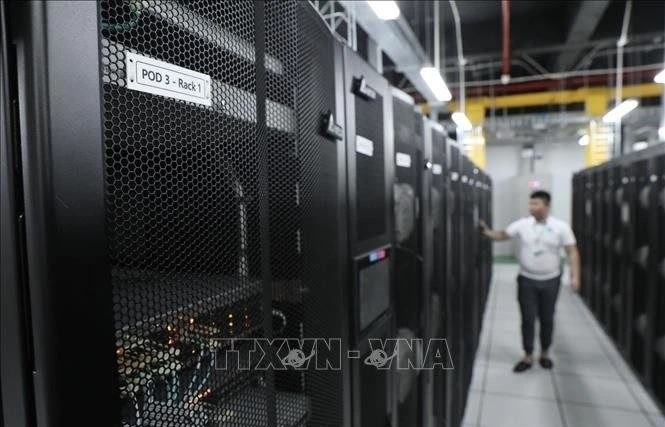












 Mobile Version
Mobile Version